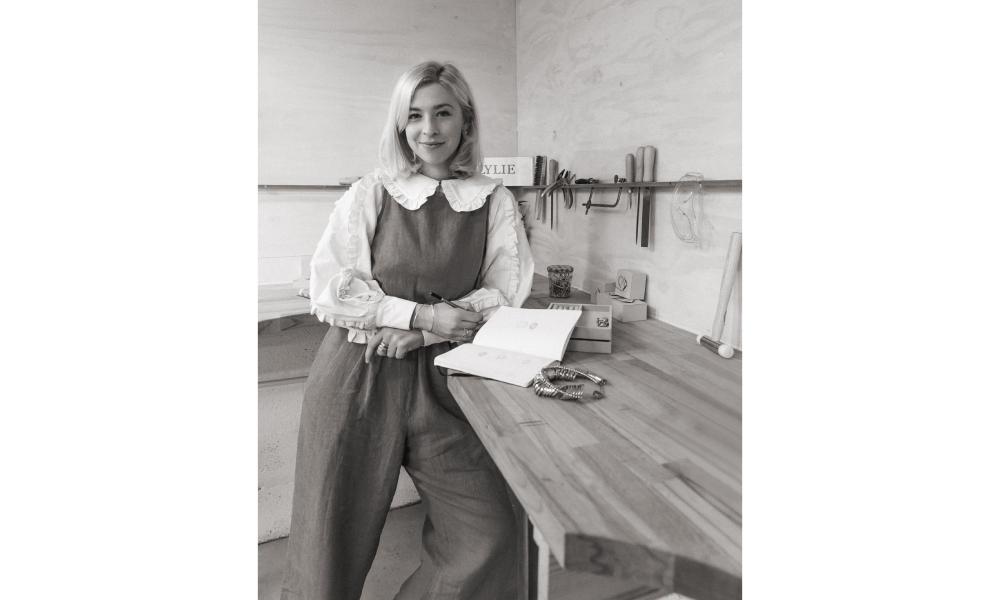Meet ELIZA WALTER, a brilliant UK-based jewellery designer and Founder of Lylie Jewellery whose journey through the intricate world of design was uniquely shaped by the challenges of dyslexia. Eliza discovered her true voice in the embrace of precious metals and shimmering gemstones and found a connection to her inner self.
Her artistry extends beyond the creation of stunning jewellery; Eliza is slowly revolutionizing the industry by championing the repurposing of old gold, aligning her work with a deep commitment to environmental sustainability. Caring for the planet has become her guiding mantra.
In Eliza’s skilled hands, precious metals transcend mere materials; they metamorphose into a medium that translates emotions, reshapes the language of art, and amplifies the urgency of preserving our ‘precious’ planet. Her creations not only adorn, but they also advocate a harmonious balance between art and environmental responsibility.
To gain a deeper understanding of your background, could you tell us about your education and whether you had always envisioned yourself becoming a jewellery designer?
I’m obsessed with art and design and am profoundly dyslexic – so much so that I was taken out of mainstream education at the age of 9 to go to a specialist boarding school called The Old Rectory, where we focused on reading and writing.
After A levels, I completed an art and design foundation course and then went to Bristol University to study History of Art. Believe it or not, I had a scribe who came to each lecture with me! Dyslexia has allowed me to approach problems in different ways and I now see it as my special gift.

What inspired you to start Lylie in 2017?
A love of design paired with wanting to make fine jewellery in a less destructive way.
In addition to bespoke commissions, could you elaborate on the process of conceptualising and bringing your collections to life? What sources of inspiration drive your creative journey?
Nature is my main source of inspiration when creating designs. Our designs have a signature granulation ball detail somewhere in/on them, which resembles the shape of earth and signifies the circular process through which our jewellery is made.
When working on collections and shoots, I have cultivated the brand’s spirit with a nod to the romantic movement; with its curiosity in folk tales, an appreciation of nature and love of the medieval period.

We’d like to know more about Lylie’s in-house gold exchange program and how it works?
We send our reusable postal pouches to collect client’s old, unworn gold, silver and platinum jewellery with a pre-paid returns label.
Once we have received the pouch and precious metal at the studio, a skilled member of staff analyses it, and gives values based on the metal carat, gemstones and weight. We offer 7.5% above the scrap metal value to incentivise recycling and if a client wants to go ahead, we exchange it for a brand credit which can be used against any purchase of LYLIE Jewellery.
We recycle the old precious metal by refining it and then casting all our collection jewellery with it. This means as a brand we are totally circular. We have amazing films and a step-by-step webpage that can be followed here: https://lylies.com/pages/gold-exchange

What challenges did you face when initially implementing this sustainable approach in the jewellery industry?
The biggest challenge has been getting the business operations in place – we had to custom-build a webpage that picks up the daily spot price of precious metals, adds the 7.5% and generates an accurate price indication for a user.
Getting the insurance in place to be covered for collecting precious metals of unknown carats is an ongoing battle. All are challenges I’d imagine any entrepreneur trying to do something slightly differently faces.

Is the concept of recycling gold catching on among consumers in the UK? Can you share some examples of the most unique or meaningful jewellery pieces that you have created from recycled gold?
Jewellery is almost always sentimental – that’s one of the things that makes working in the industry hugely fulfilling.
A recent example is a longstanding client sent in all her grandmother’s old pieces she didn’t want, including a 9-karat gold purse! The got a credit note that exceeded £3,000 and with that, can purchase something for her and her daughter that they both really love.

In the past, you delved into recycling gold from e-waste? Could you share the story of how you first became interested in this unique endeavour?
When I was 16, I was taken on a school trip to a local foundry where it was explained that our mobile phones’ circuit boards contain gold, platinum and silver.



